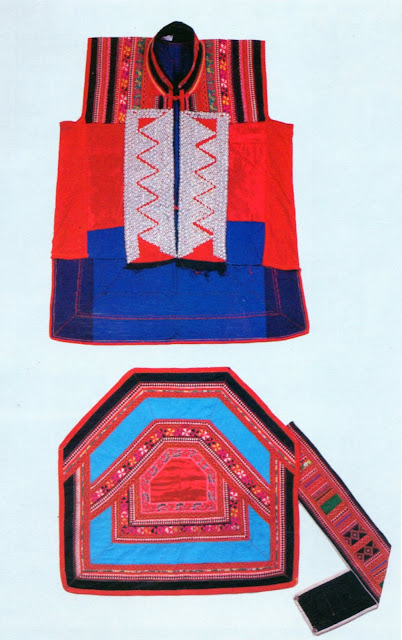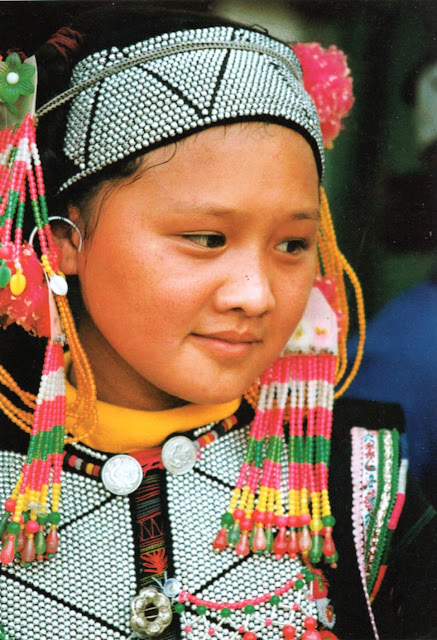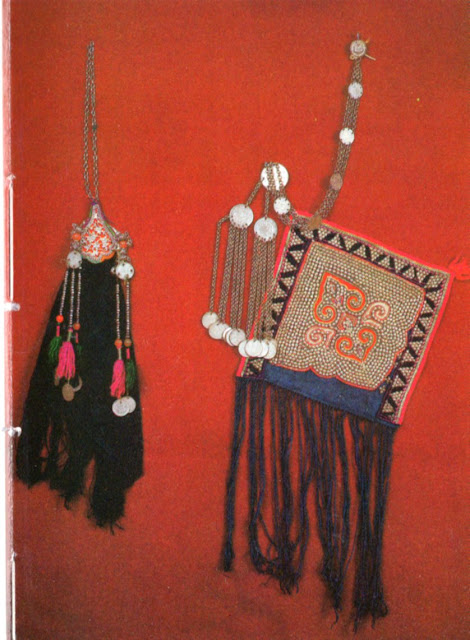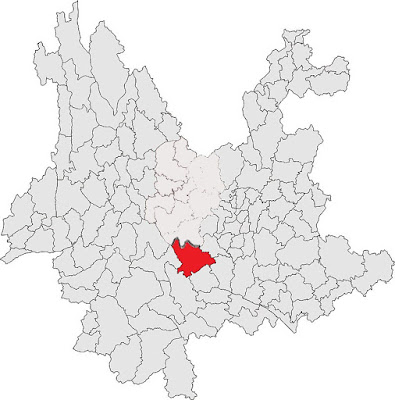Hello all,
Today I will talk about the Nisu, or Southern Yi to continue my series on Sino Tibetan Costumes. In the southern part of this region, the dominant ethnicity is the Hani, and there has been a certain amount of Hani influence on the dress of the Yi in the southern counties in this region
This group lives in southern Yunan, mostly in Honghe Prefecture. Here is a rough map of this area.
https://en.wikipedia.org/wiki/Southern_Yi
There are three main branches of this group, each of which has sub branches.
Shiping Style
Shiping County
This group is often called the Huayao Yi [Flowery waisted] by the Han. [not to be confused with the Huayao Dai] I have also found them referred to as the Suni Yi. This costume is exceptionally colorful, even for the Yi. They are found in Shiping County and part of Eshan County. The image at the head of the article shows women from this group doing a dragon dance. Here is another image from the dragon festival.
The woman's costume consists of a long sleeved gown over which is worn a vest which is open on the sides. The front part of the gown under the overlap has ornament, so it is pulled to the side and tucked in to the waist. A complex headdress, ties hanging from the waist and ornamented pants complete the outfit.
gown
vest
headdress
waist ornaments
The back hem often features embroidered flame designs. More evidence of the Yi reverence for the element of fire.
The men's festive outfit includes an embroidered jacket, belt, leggings and sandals. This couple is serenading each other, the man on the pipa, and the girl is playing a leaf.

Here is an embroidered baby carrier.
A few more images of this costume.

Here is a short movie set in this region about a young couple. The dialogue, I believe is in Nisu, with Mandarin and English Subtitles.
https://www.youtube.com/watch?v=LHCGrUqkJQ4
Kaiyuan County
The costume in this county has a similar structure, short jacket and pants with a vest and apron over it. The costume has been especially conserved in the village of Beyge.
The men traditionally wore a jacket with side opening, as well as embroidered sash and apron
Women's pants and jacket
vest and apron worn over the pants.
back of the vest.
In Beyge village, the headdress used to consist of a mass of fake hair.
In Kaiyuan county today, the women wer a tall cap covered with silver bulbs.
Gejiu County
Jiasha town in Gejiu County has a distinctive costume
The shirt is fastened on the right side, but the vest closes in the middle. The hair is wrapped in red yarn, a band with coins is fastened across the forehead, and an embroidered cloth is often wrapped over all.
Pingbian and Mengzi Counties
This costume consists of a shirt which attaches at the side and is longer in the back, a vest which likewise is long in the back, a colorful apron, and a headdress of tassels which stick up like a peacock's tail.
Older women wear a veil over the headdress. This symbolizes the triumph of wisdom and prudence over vanity.
Jinping County
In contrast to the above costumes this one is mostly black with the main ornament being silver bulbs attached to the clothing.
Jianshui Style
This is the central style of costume, being found in a band from Jianshui to the southeast. This style shows the most assimilation to modern Han clothing. This type of wear is very common within this area.
This example is from Guanting Village, Gaoshan mountain area. Traditionally, there is a shirt and pants.
Over which is worn a vest,
The headdress consists of red yarn wound around the hair, as in Gejiu County above, then covered with a black kerchief.
Here is an example of a man's jacket from this region.
Many people, especially younger ones, replace part of this ensemble with modern clothing, especially the shirt and/or pants, and wearing a towel on the head.
Older women from Eshan, Xingping, Shuangbai and Yimen wear looser fitting clothing which hearkens back to the Qing Dynasty.
Some areas have kept unique headdresses.
Mengzi County. they use various cloths, but still wrap them in a unique fashion.
Laochang village in Gejiu
Anlongbao of Shuangbai.
Yuanyang Style
This is worn in the southwest part of this area, from Honghe County south to Yuanyang.
Yuanyang County
This costume is also worn in parts of Jinping County.
Like the costume of Jinping County, and Wushan of Mile County, this one has many silver bulbs attached.
The basal layer consists of a shirt and pants with ornamented cuffs and lower sleeves.
The second layer consists of a long gown with half sleeves, over which is worn a vest with many silver ornaments.
Another vest.
The headdress is shaped like a cockscomb, and is also covered with silver ornaments. These examples are from Jinping.

In this image, the upper hat is from Honghe County, and the two lower ones are from Yuanyang County.
Various waist ornaments are an important part of the costume, which are also studded with silver.
Starting in the 1970's, the silver bulbs began to be replaced by white cashmere embroidery, which was cheaper and lighter. In the above image you can see the silver on the woman in the middle, and the white embroidery on the woman on the right. Here are some more examples.
These waist ornaments remain an important part of the costume.
As you can see, the cockscomb caps are still worn, but narrow cloths with embroidered ends are also worn. The front part of the long gown is often pulled to the back. This may show off the ornament.
Little girls still like the caps.
A video showing some scenes of daily life in Yuanyang. Narrated in French.
https://www.youtube.com/watch?v=7kf6d78os_0
A video of Yuanyang Yi doing a dance in simplified modern costume.
https://www.youtube.com/watch?v=V5Er57FupWY
Another dance video.
https://www.youtube.com/watch?v=9Osfl7HZ9Gs
Honghe County
This costume is similar, but has its own distinct details. Here is the basic costume of Honghe.
In this above image, you can see the caps with open centers, as was shown above in the image of the three caps. The waist ornaments are also distinct.
Here is a baby carrier, also from Honghe.
Xinping County
This costume is worn in the Mopan and Lukui Mountain areas of Xinping County.
This costume is similar to that of Yuanyang, although simpler in ornament. There is a pair of loose pants and a shirt, over which is worn a long gown whose front part is pulled around to the back.
There is a waistband, a sash, a very short apron and a waist ornament worn over these. The apron is at the top of this image.
A turban with embroidered ends which stick up to the sides, and embroidered shoes complete the outfit.
Here you can see the short aprons, the turbans, and also the triangular kerchief which is worn by some of the women.
I have one image of a woman from a different group in Xinping, but I have no more information on this costume.
Jiangcheng County
This county lies in the extreme southeast of Puer Prefecture. The costume is similar, but quite understated. A vest is worn over the long gown, which again is pulled around to the back.
Lüchun County
This costume is another of the same general type, worn in the border region of Honghe and Lüchun Counties. This one has very distinct ornamental embroidery. Note their own version of the cockscomb cap. Again we see pants, a shirt, and a long gown with the front pulled around to the back.
This concludes my treatment of the costumes of the southern Yi.
Thank you for reading, I hope that you have found this to be interesting and informative.
Roman K.
email: rkozakand@aol.com
Source Material:
Unknown Author, 'The Costumes and Adornments of Chinese Yi Nationality Picture Album', Beijing, 1990Deng Qiyao et al, 'The Folk Arts of Yunnan Ethnics', Yunnan, 1993
Chen Hongguang et al, 'Ethnic Costumes Clothing Decorations from China', Chengdu, Sichuan, 1995
Bernard Formoso, 'Costumes du Yunnan', Nanterre, 2013
Shan Ren et al, 'The Cream of Yunling - A Photo Odyssey of Yunnan Ethnic Groups', Kunming, 1998




























































































































The article "Costumes of the Sino-Tibetan Peoples - Part 2" on the Folk Costume blog provides an interesting overview of the costumes of the Sino-Tibetan peoples. This is a fascinating journey into the diversity of cultural and traditional aspects of these peoples through the prism of their national costumes. When personal questions arise and you require consultation on various aspects of psychology, health or other personal issues, I would like to mention this clinic. They specialize in providing confidential and professional services in the field of psychology and general well-being. The clinic can offer personalized advice and support for those seeking help and advice with their unique issues.
ReplyDeleteHodl.fm is my daily crypto news hub! Their coverage of the latest events in the crypto sphere is spot on. I make it a habit to check their website for updates on market trends, emerging projects, and regulatory shifts. It's like having a reliable crypto compass for navigating this ever-changing landscape.
ReplyDeleteThis post on the costumes of Sino-Tibetan peoples is truly fascinating! It's amazing how deeply culture is reflected in traditional attire. For anyone looking to delve into academic research on cultural studies or related topics, services like quality-essay.com can provide valuable support in crafting well-researched essays. Their assistance could really help in exploring topics like this in more depth!
ReplyDelete